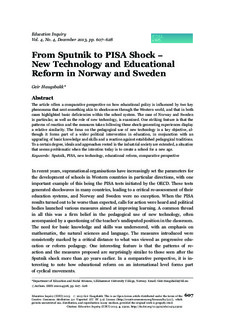| dc.description.abstract | The article offers a comparative perspective on how educational policy is influenced by two key phenomena that sent something akin to shockwaves through the Western world, and that in both cases highlighted basic deficiencies within the school system. The case of Norway and Sweden in particular, as well as the role of new technology, is examined. One striking feature is that the patterns of reaction and the measures taken following these shock-generating experiences display a relative similarity. The focus on the pedagogical use of new technology is a key objective, although it forms part of a wider political intervention in education, in conjunction with an upgrading of basic knowledge and skills and a reaction against established pedagogical traditions. To a certain degree, ideals and approaches rooted in the industrial society are extended, a situation that seems problematic when the intention today is to create a school for a new age. | nb_NO |
